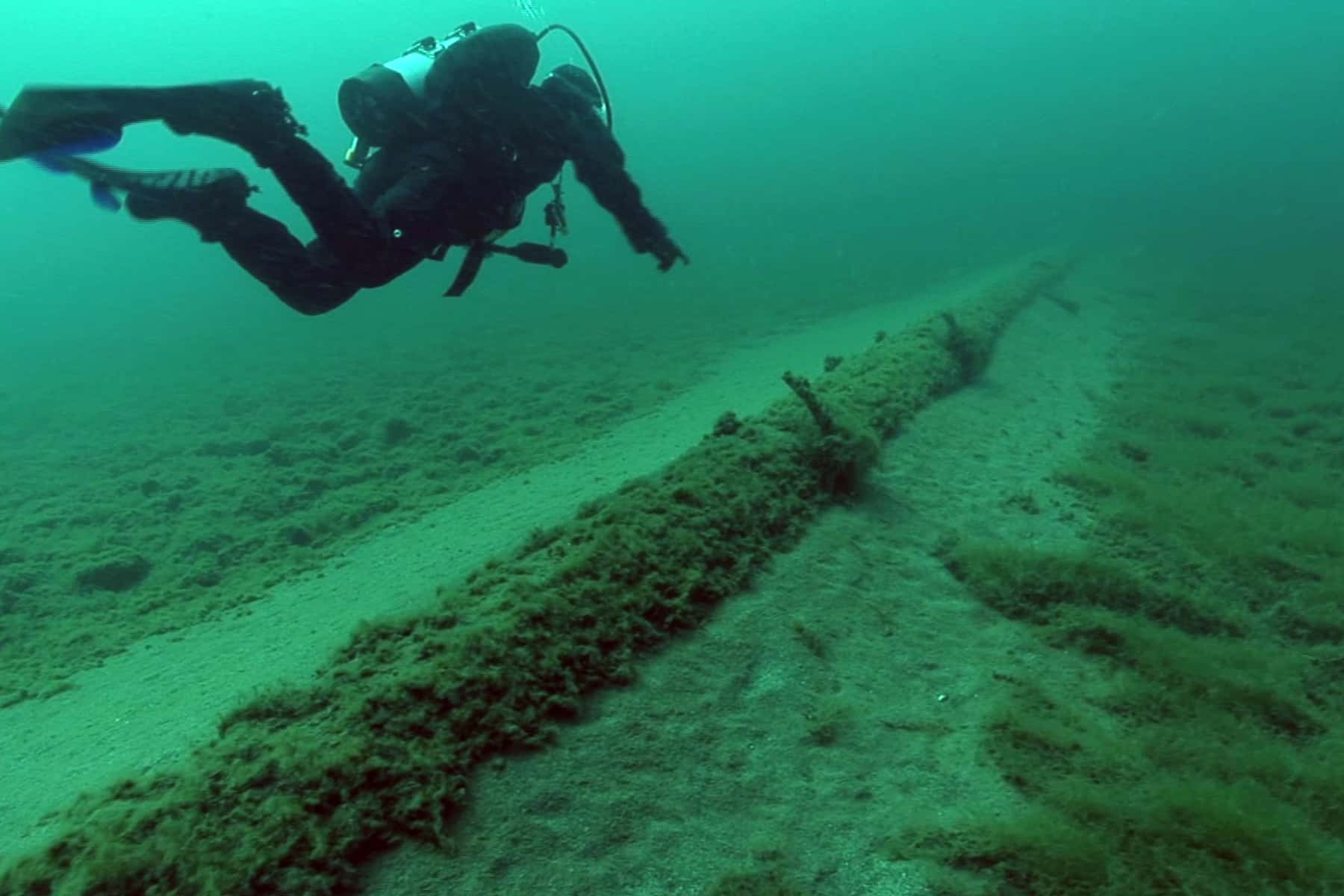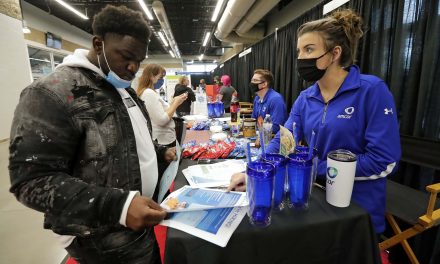
A coalition of environmental groups and newly elected Democrats in Michigan are seeking to shut a controversial pipeline through the Great Lakes they say represents a major environmental threat and is being run by a company with a long record of mismanagement, poor safety habits and deception.
Canadian oil giant Enbridge wants to replace an aging pipeline called Line 5 that cuts through the Great Lakes, which hold more than 90% of the nation’s freshwater. It transports about 540,000 barrels of oil and liquid natural gas daily in 4.4 miles of pipelines that are exposed on the lake floor in the Mackinac Straits.
The Straits connect Lake Huron and Lake Michigan between the state’s upper and lower peninsulas, and there’s fear that an anchor strike or powerful shifting currents could put enormous stress on the aging pipes and trigger a disaster.
Critics also note Enbridge has been responsible for dozens of leaks, missed safety inspections, and has lied to state officials and the public about its deteriorating pipelines. Its deceptions drew criticism even from pro-business figures like the former Michigan governor Rick Snyder, while a federal investigation of the company highlighted what it called “pervasive organizational failure.”
One incident in particular occurred in 2010 when a pipeline belonging to Enbridge ruptured and began pumping heavy crude into Michigan’s Kalamazoo River. A warning system alerted operators, but the employees misread the signals, mistakenly believing that the line had lost pressure. Instead of immediately shutting it down, they increased pressure for 17 hours.
The error resulted in the nation’s costliest inland oil spill. Enbridge’s line ultimately leaked around 1m gallons of heavy crude that contaminated 38 miles of the river and required a $1.5B cleanup that some environmental groups say was never completed.
But despite its lengthy rap sheet and Line 5 itself leaking over 1m barrels of oil in recent decades, Republicans in Michigan’s state legislature pushed through legislation to get the project started during the 2018 “lame duck” session before incoming Democrats had taken office.
Critics want the project stopped
“It would be a mistake for the state to continue to work with Enbridge,” said David Holtz, director of campaign group Oil and Water Don’t Mix. “The best predictor of future behavior is past behavior, and if you look at Enbridge’s past behavior, then you know you can’t trust them.”
Because of the conditions and geography, the Mackinac Straits are “the worst possible place for an oil spill in the Great Lakes”, a 2014 University of Michigan and National Wildlife Federation study concluded. Unpredictable, strong winds and currents could quickly spread oil across 700 miles of Great Lakes shoreline, and cleanup would be virtually impossible in the region’s frigid winter.
Moreover, the deal would largely benefit Canada while Michigan would absorb the risk. Oil in Line 5 arrives from western Canada’s tar sand pits and is transported about 650 miles from northern Wisconsin to Sarnia, Ontario. Michigan is mostly just a shortcut: only about 10% of Line 5’s oil stays here.
Enbridge’s plans for the replacement line call for a $500m utility tunnel to be dug out 100ft below the Mackinac Straits floor. The company claims the tunnel would protect pipelines from an anchor strike and other threats. Work began in January, but newly elected Democrat attorney general Dana Nessel in March issued a legal opinion declaring the Republican lame duck law unconstitutional. That halted state work and could ultimately kill the plans if Nessel’s opinion holds up in court.
Separately, Nessel plans to move forward in June with a lawsuit asking a court to immediately order the current line shut down. Though her office declined to comment on legal strategy, the line’s opponents say Enbridge is clearly violating a 1953 easement, which Holt said requires the company to keep the pipeline in good condition.
Enbridge has insisted its lines are in compliance with the agreement, but evidence contradicts those claims. The easement requires support mechanisms every 75ft to stabilize the line, but National Wildlife Federation divers in 2013 found 16 locations in which at least 140ft of pipelines weren’t supported, prompting US senator Gary Peters to say: “Clearly, there was violations of the easement.”
Similarly, state officials discovered in 2017 that Enbridge lied about the status of protective coating around Line 5. The company knew gaps existed in the protective coating in 2014 but didn’t tell the state. It then denied in 2017 that bare metal was exposed, but that turned out to be untrue.
The revelations came as Enbridge continued asserting that it learned its lesson from the 2010 Kalamazoo spill and improved its corporate culture. Enbridge spokesman Ryan Duffy told the Guardian that the post-Kalamazoo company is “even more acutely aware of and deeply focused on safety.”
“The spill is etched on our DNA as a company and will continue to drive our relentless efforts to deliver on our number one priority of safety and protection of the environment, and achieving our goal of zero incidents,” he said.
However, the state house minority floor leader, Yousef Rabhi, said Enbridge wanted to “greenwash their corporation and make it seem like they changed since creating one of the largest manmade disasters in Michigan, but clearly they have not.”
Critics point out that between 2002 and 2018, Enbridge was responsible for more than 300 oil and hazardous liquid spills, and in recent months its liquid natural gas pipelines exploded in British Columbia and Ohio. And while the Kalamazoo disaster was the costliest inland oil spill, a 1991 Enbridge rupture that leaked 1.6m gallons of crude into a river near Grand Rapids, Minnesota, remains the largest on record.
Meanwhile, Line 5 has leaked 33 times since federal agencies began tracking its spills in 1968, according to the NWF. The bulk of those were the result of faulty equipment or operator error. That includes oil found in the ground in 2011 at a pumping station just off the Straits’ coast that required the removal of 360 tons of contaminated soil.
In 2018, the worst fears for environmentalists nearly came true when a tugboat anchor struck Line 5, and another nearby line that leaked about 600 gallons of fluid. Enbridge minimized the damage in comments to state officials and the public, but it was later revealed that the line sustained serious dents that threatened its integrity. In response senator Peters held a hearing in which he underscored the “significant deficiency of trust” in Enbridge. The company denied that the line was ever in danger.
Such disputes are partly what sets Enbridge apart from other companies, said Beth Wallace, Great Lakes partnerships manager at the NWF. She noted that NWF data shows Enbridge has fewer spills per mile of pipeline than many similar companies, but its “safety culture” and “lack of transparency” are problematic.
“They’re not the worst when it comes to history of failures, but it’s also how you respond and react to a spill, and how you change your culture,” she said. “When it comes to that, they have a pretty bad track record of working with communities.”
Tom Perkins
National Wildlife Federation
Originally published on The Guardian as Critics seek to stop Great Lakes pipeline run by company with poor safety habits
Help deliver the independent journalism that the world needs, make a contribution of support to The Guardian.














